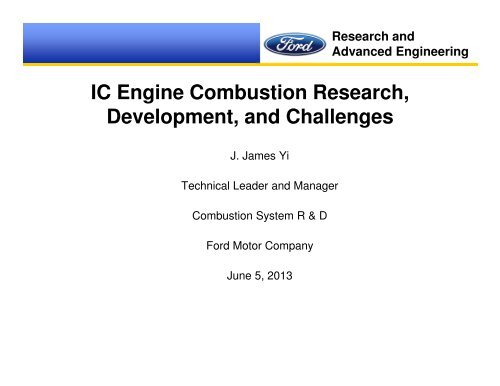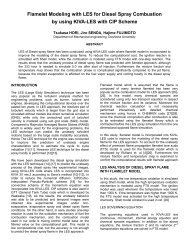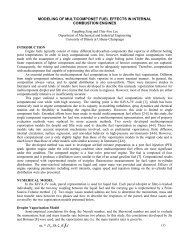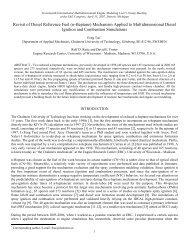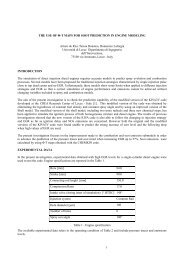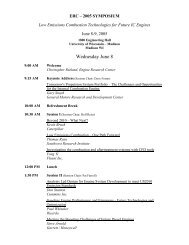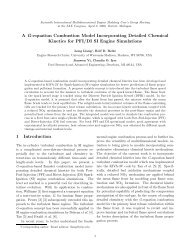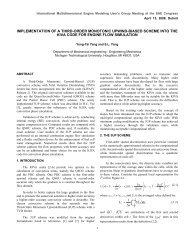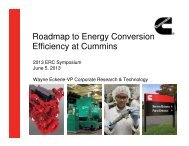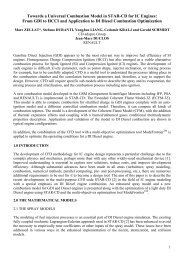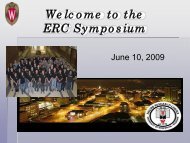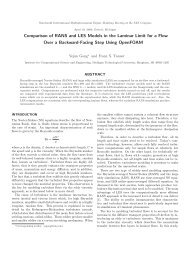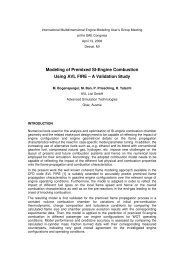Research and Development of Ford Advanced Combustion ...
Research and Development of Ford Advanced Combustion ...
Research and Development of Ford Advanced Combustion ...
Create successful ePaper yourself
Turn your PDF publications into a flip-book with our unique Google optimized e-Paper software.
<strong>Research</strong> <strong>and</strong><br />
<strong>Advanced</strong> Engineering<br />
IC Engine <strong>Combustion</strong> <strong>Research</strong>,<br />
<strong>Development</strong>, <strong>and</strong> Challenges<br />
J. James Yi<br />
Technical Leader <strong>and</strong> Manager<br />
<strong>Combustion</strong> System R & D<br />
<strong>Ford</strong> Motor Company<br />
June 5, 2013<br />
1
Outline<br />
<strong>Research</strong> <strong>and</strong><br />
<strong>Advanced</strong> Engineering<br />
Technology Drivers<br />
<strong>Ford</strong>’s Global Technology Migration<br />
Strategy<br />
<strong>Ford</strong> EcoBoost <strong>Combustion</strong> system<br />
<strong>Development</strong><br />
Future <strong>Research</strong> Opportunities<br />
Summary<br />
2
Future CO 2 Requirements<br />
<strong>Research</strong> <strong>and</strong><br />
<strong>Advanced</strong> Engineering<br />
New Fleet LDV Gasoline Equivalent<br />
g CO 2 / km<br />
0<br />
U.S. CAFE /<br />
CO 2 St<strong>and</strong>ard<br />
EU Legislation<br />
NA: Metro-Highway test cycle<br />
EU: NEDC test cycle<br />
U.S. One National St<strong>and</strong>ard<br />
(35.5 mpg in 2016)<br />
New Proposal<br />
(54.5 mpg in 2025)<br />
NA WRE450<br />
EU WRE450<br />
2000 2005 2010 2015 2020 2025 2030 2035<br />
Model Year<br />
Aggressive CO 2 fleet targets will require advanced technologies for a<br />
variety <strong>of</strong> P/T combinations <strong>and</strong> vehicle applications.<br />
3
Emissions Regulations<br />
<strong>Research</strong> <strong>and</strong><br />
<strong>Advanced</strong> Engineering<br />
Emissions Regulations<br />
7<br />
6<br />
PM (mg\km)<br />
5<br />
4<br />
3<br />
2<br />
1<br />
SULEV30<br />
Stage VII<br />
Forecast<br />
T2B5<br />
*<br />
Stage VI *<br />
Stage V<br />
0<br />
0 50<br />
100<br />
150<br />
200 250<br />
*Estimated from particle number<br />
NOx + HC (mg/km)<br />
Along with more stringent Nox <strong>and</strong> UHC emissions st<strong>and</strong>ard, Particulate emissions<br />
st<strong>and</strong>ards are reaching a level that has an impact not only on diesel vehicles, but also<br />
gasoline vehicles.<br />
4
Global Technology Migration<br />
Strategy<br />
<strong>Research</strong> <strong>and</strong><br />
<strong>Advanced</strong> Engineering<br />
2007 2011 2020 2030<br />
Begin migration to<br />
advanced technology<br />
Full implementation <strong>of</strong><br />
known technology<br />
Continue leverage <strong>of</strong> Hybrid<br />
technologies <strong>and</strong> deployment <strong>of</strong><br />
alternative energy sources<br />
Significant number <strong>of</strong> vehicles with<br />
EcoBoost engines<br />
Flex Fuel Vehicles<br />
Increased hybrid applications<br />
Stop/Start systems (micro hybrids)<br />
introduced<br />
Dual clutch <strong>and</strong> 6 speed<br />
transmissions replace 4 & 5 speeds<br />
Electric power steering – begin<br />
global migration<br />
Increased unibody applications<br />
Introduction <strong>of</strong> additional small<br />
vehicles<br />
Battery management systems –<br />
begin global migration<br />
Aero improvements<br />
CNG/LPG Prep Engines available<br />
where select markets dem<strong>and</strong><br />
• EcoBoost engines available in nearly<br />
all vehicles<br />
• Vehicle capability to fully leverage<br />
available renewable fuels*<br />
• Increased application <strong>of</strong> Stop/Start<br />
• Increased use <strong>of</strong> Hybrid Technologies<br />
• Introduction <strong>of</strong> PHEV <strong>and</strong> BEV<br />
• Diesel use as market dem<strong>and</strong>s<br />
Electric power steering - High volume<br />
Six speed transmissions - High<br />
volume<br />
• Weight reduction <strong>of</strong> 250 – 750 lbs<br />
• Engine displacement reduction<br />
aligned with weight save<br />
• Additional Aero improvements<br />
• Continue improving efficiency <strong>of</strong><br />
internal combustion engines<br />
• Volume expansion <strong>of</strong> Hybrid <strong>and</strong><br />
PHEV technologies<br />
• Continued leverage <strong>of</strong> BEV<br />
• Continue to develop fuel cells;<br />
implementation timing aligned with<br />
fuels <strong>and</strong> infrastructure<br />
• Continued weight reduction actions<br />
via advanced materials<br />
<strong>Ford</strong> believes that the IC engine will play a key role in transportation in the near <strong>and</strong><br />
mid-term <strong>and</strong> will continue to develop technologies to further extend its potential.<br />
5
Near-Term CO 2 Reduction<br />
<strong>Research</strong> <strong>and</strong><br />
<strong>Advanced</strong> Engineering<br />
In the near-term, <strong>Ford</strong> has been adopting an aggressive strategy for both<br />
gasoline <strong>and</strong> diesel engines to reduce fuel consumption in major markets.<br />
Taurus<br />
SHO<br />
EcoBoost<br />
3.5L V6 Gasoline Engine<br />
2011 Super<br />
Duty<br />
<strong>Ford</strong> Fiesta<br />
1.6L I4 Duratorq<br />
Diesel Engine<br />
All-New 6.7L Power<br />
Stroke® V8 Turbo Diesel<br />
6<br />
23
Outline<br />
<strong>Research</strong> <strong>and</strong><br />
<strong>Advanced</strong> Engineering<br />
Technology Drivers<br />
<strong>Ford</strong>’s Global Technology Migration<br />
Strategy<br />
<strong>Ford</strong> EcoBoost <strong>Combustion</strong> system<br />
<strong>Development</strong><br />
Future <strong>Research</strong> Opportunities<br />
Summary<br />
7
EcoBoost Principles – Best Brake<br />
Thermal Efficiency (BTE)<br />
<strong>Research</strong> <strong>and</strong><br />
<strong>Advanced</strong> Engineering<br />
20<br />
Peak Torque<br />
GTDI<br />
Peak<br />
Power<br />
BMEP (bar)<br />
15<br />
10<br />
Baseline PFI NA<br />
GTDI Extends the<br />
High Efficiency<br />
region as well as<br />
the torque curve<br />
5<br />
FTP<br />
• Boosting exp<strong>and</strong>s the good BTE isl<strong>and</strong><br />
• Downsizing shifts it to area <strong>of</strong> higher utilization<br />
0<br />
0 1000 2000 3000 4000 5000 6000<br />
Speed (rpm)<br />
• FTP Drive Cycle typically centered about the ~25% load point for NA engines.<br />
• For a naturally aspirated engine best BTE is typically about 80% load.<br />
• GTDI greatly exp<strong>and</strong>s the best BTE isl<strong>and</strong>.<br />
• Downsizing will move the GTDI best BTE isl<strong>and</strong> to a useable range.
Technical Challenge: DI vs. PFI<br />
<strong>Research</strong> <strong>and</strong><br />
<strong>Advanced</strong> Engineering<br />
1. Cold start crank <strong>and</strong> run-up emissions are much more challenging in a DI<br />
engine than PFI<br />
2. Over entire speed <strong>and</strong> load operation map, mixing in a DI engine is much<br />
more challenging than PFI.<br />
3.5L V6 PFI<br />
3.5L V6 GTDI<br />
Slide 9
Added Technical Challenge With<br />
Turbo DI<br />
<strong>Research</strong> <strong>and</strong><br />
<strong>Advanced</strong> Engineering<br />
3. Turbo DI combustion system is more prone to knock due to higher power<br />
density than naturally aspirated engines.<br />
4. Turbocharging makes engine cold-start even more challenging because it<br />
requires more heat to light <strong>of</strong>f catalyst due to heat loss to the turbo<br />
system.<br />
ENGINE<br />
Heat Flux > 2x W/L<br />
•Extra surface area /<br />
thermal mass due to<br />
turbocharger.<br />
CAT.<br />
Heat Flux > x W/L<br />
Slide 10
Integrated Up-front <strong>Combustion</strong> System<br />
Optimization Methodology<br />
<strong>Research</strong> <strong>and</strong><br />
<strong>Advanced</strong> Engineering<br />
Numerical Modeling<br />
Optimized Design<br />
Dyno Testing<br />
Optical Engine
Injector Spray Pattern<br />
Optimization<br />
Series - I<br />
Series - II<br />
<strong>Research</strong> <strong>and</strong><br />
<strong>Advanced</strong> Engineering<br />
Series - III<br />
Baseline Injector<br />
Smoke (FSN)<br />
Smoke (FSN)<br />
1.5<br />
1.0<br />
0.5<br />
1500rpm/5bar<br />
Baseline Injector Spray Pattern<br />
Optimized Injector Spray Pattern<br />
15 o<br />
Optimized Injector<br />
0.0<br />
270 280 290 300 310<br />
SOI (deg. BTDC)<br />
Slide 12
Piston Bowl Geometry Optimization<br />
Baseline Piston<br />
<strong>Research</strong> <strong>and</strong><br />
<strong>Advanced</strong> Engineering<br />
Optimized Piston<br />
A/F<br />
lean<br />
Modeling<br />
Prediction<br />
rich<br />
Optical<br />
Images<br />
•CA=760<br />
Rich<br />
lean<br />
•CA=760<br />
Mixture <strong>of</strong>f-center<br />
Mixture well-centered
Spray-Piston Interaction <strong>and</strong> Its<br />
Impact on <strong>Combustion</strong> Stability<br />
<strong>Research</strong> <strong>and</strong><br />
<strong>Advanced</strong> Engineering<br />
Slide 14
Spray-Piston Interaction <strong>and</strong> Its<br />
Impact on <strong>Combustion</strong> Stability<br />
<strong>Research</strong> <strong>and</strong><br />
<strong>Advanced</strong> Engineering<br />
Slide 15
System <strong>Development</strong><br />
Methodology – Quality & Time<br />
<strong>Research</strong> <strong>and</strong><br />
<strong>Advanced</strong> Engineering<br />
Design Optimization<br />
Single Cylinder Optical /<br />
Thermal<br />
Multi Cylinder<br />
•Multi-hole<br />
Spray<br />
•Piston<br />
•Intake<br />
Port<br />
50+<br />
iterations<br />
Outline<br />
<strong>Research</strong> <strong>and</strong><br />
<strong>Advanced</strong> Engineering<br />
Technology Drivers<br />
<strong>Ford</strong>’s Global Technology Migration<br />
Strategy<br />
<strong>Ford</strong> EcoBoost <strong>Combustion</strong> system<br />
<strong>Development</strong><br />
Future <strong>Research</strong> Opportunities<br />
Summary<br />
17
EcoBoost – Future<br />
Technology <strong>Development</strong><br />
<strong>Research</strong> <strong>and</strong><br />
<strong>Advanced</strong> Engineering<br />
NA 4V<br />
DOHC<br />
PFI<br />
CO 2<br />
Variable<br />
Cam<br />
Timing<br />
DI<br />
Homogeneous<br />
(incl. CR)<br />
Naturally Aspirated path<br />
EcoBoost –<br />
Technology progression<br />
Direct Injection<br />
+<br />
Turbocharging<br />
+<br />
Downsizing<br />
EcoBoost<br />
Turbocharger<br />
& Downsizing<br />
(architecture)<br />
Proven<br />
Under<br />
capability<br />
devel.<br />
Increased BMEP<br />
<strong>Advanced</strong> Boosting<br />
Knock mitigation<br />
Improved BTE:<br />
- Cooled EGR<br />
Time<br />
EcoBoost –<br />
Future advancements<br />
Multi-stage Boosting<br />
Full-range Cooled EGR<br />
Max. low-load load efficiency<br />
(Lean, HCCI,…)<br />
Future powertrain versions <strong>of</strong> EcoBoost will improve fuel<br />
economy <strong>and</strong> emissions capability.
Department <strong>of</strong> Energy<br />
Funding Award<br />
<strong>Research</strong> <strong>and</strong><br />
<strong>Advanced</strong> Engineering<br />
• <strong>Advanced</strong> Gasoline Turbocharged Direct Injection Engine <strong>Development</strong><br />
• Joint project w/ Michigan Technological University (MTU)<br />
• Demonstrate by modeling / analysis <strong>and</strong> with a full-scale vehicle the ability to<br />
achieve greater than 25% weighted fuel economy improvement with a gasoline<br />
engine / conventional automatic transmission, while meeting T2B2 emissions<br />
st<strong>and</strong>ard.<br />
CCC TWC(s)<br />
Enrichment Zone<br />
Lean after<br />
treatment<br />
RWFE<br />
BMEP<br />
A/T<br />
Lean <strong>Combustion</strong><br />
Cooled EGR<br />
Integrated<br />
CAC<br />
Throttle<br />
Air<br />
Filter<br />
Intake Manifold<br />
IEM<br />
W<br />
T<br />
G<br />
BFT<br />
C<br />
<strong>Advanced</strong><br />
wide range<br />
Boost<br />
<strong>Development</strong> <strong>of</strong> advanced EcoBoost technologies will be<br />
19<br />
a major focus.<br />
Cat<br />
EGR<br />
Cooler<br />
LP EGR<br />
Valve<br />
Muffler<br />
LP EGR Throttle
<strong>Advanced</strong> <strong>Combustion</strong> Modes<br />
<strong>Research</strong> <strong>and</strong><br />
<strong>Advanced</strong> Engineering<br />
6<br />
LTC / HCCI<br />
Equivalence Ratio Φ = 1/λ<br />
5<br />
4<br />
3<br />
2<br />
1<br />
CO-HC<br />
LTC Path.<br />
Soot-Production<br />
Conv. Path<br />
NO x Production<br />
0<br />
600 1000 1400 1800 2200 2600<br />
HCCI Path<br />
Temperature [K]<br />
Comb. Noise<br />
LTC<br />
3000<br />
High Efficiency<br />
Low NOx<br />
Low PM<br />
Trade<strong>of</strong>f<br />
Fuel Consumption<br />
<strong>Combustion</strong> noise control is critical, but<br />
<strong>of</strong>ten there is an efficiency-noise trade<strong>of</strong>f<br />
20
Knock Mitigation Via Reducing<br />
Cycle-Cycle Variation<br />
<strong>Research</strong> <strong>and</strong><br />
<strong>Advanced</strong> Engineering<br />
• Knock limits fuel consumption<br />
benefits<br />
– Limits compression ratio<br />
– Forces spark retard <strong>and</strong>, in the<br />
limit, forces enrichment (both limit<br />
downsizing potential)<br />
• In the case <strong>of</strong> knocking condition,<br />
only a small portion <strong>of</strong> fast burn<br />
events are with knocking.<br />
21
Injection <strong>and</strong> Spray Atomization<br />
-- Example <strong>of</strong> Flash Boiling<br />
A DI Spray 12.5 cc/s @ 10 MPa)<br />
<strong>Research</strong> <strong>and</strong><br />
<strong>Advanced</strong> Engineering<br />
Winter-blend Gasoline, 1 ms<br />
1.5 ms PW ~ 14 mg<br />
20º C<br />
1 bar<br />
100 bar<br />
Fuel Temperature<br />
Ambient Pressure<br />
Fuel Pressure<br />
90º C<br />
0.5 bar<br />
100 bar
Soot Formation in DI Engines<br />
<strong>Research</strong> <strong>and</strong><br />
<strong>Advanced</strong> Engineering<br />
Viewing Direction<br />
23
SI Particulate Formation<br />
<strong>Research</strong> <strong>and</strong><br />
<strong>Advanced</strong> Engineering<br />
Rich <strong>and</strong> Hot<br />
φ > 2<br />
T > 1800 K<br />
Bulk Vapor<br />
Droplets<br />
Near Liquid<br />
Film<br />
•Mixing<br />
•Atomization<br />
•Volatility<br />
•Atomization<br />
•Volatility<br />
•Spray Targeting<br />
•Surface Temp.<br />
Usually easy to avoid<br />
Hard to eliminate<br />
Unlike diesel engines,<br />
gasoline particulate<br />
formation is not driven by<br />
mixing processes, but<br />
surface wetting.<br />
What is the role <strong>of</strong> fuel composition<br />
How well do we know the<br />
rich zone characteristics<br />
Is it evaporated by the<br />
time the flame passes<br />
How much fuel<br />
actually sticks<br />
c≡c<br />
FILM<br />
What level <strong>of</strong> soot formation<br />
chemistry detail is appropriate<br />
to predict soot yield<br />
How much liquid fuel<br />
reaches the<br />
surface<br />
To model PM, we will need to accurately answer a number <strong>of</strong> open questions.<br />
24
Summary<br />
<strong>Research</strong> <strong>and</strong><br />
<strong>Advanced</strong> Engineering<br />
The integrated upfront combustion system optimization<br />
process (modeling, optical engine, dyno) is the key to<br />
designing high quality combustion system with high<br />
efficiency; It has been applied in all <strong>Ford</strong> recent IC<br />
engine development.<br />
Further underst<strong>and</strong>ing <strong>of</strong> fundamental physics is the<br />
key to the advanced combustion system development<br />
– <strong>Advanced</strong> combustion mode (lean, LTC, RCCI, EGR,…)<br />
– Fuel Injection <strong>and</strong> spray atomization (flash boiling,…)<br />
– Knock mitigation <strong>and</strong> Cyclic phenomena underst<strong>and</strong>ing <strong>and</strong> control<br />
– Emissions especially soot emissions formation mechanism <strong>and</strong><br />
mitigation gasoline engine particulates<br />
– Noise trade<strong>of</strong>fs <strong>and</strong> noise reduction in advanced combustion modes<br />
25
<strong>Ford</strong>/ORNL <strong>Combustion</strong><br />
Variation Modeling<br />
<strong>Research</strong> <strong>and</strong><br />
<strong>Advanced</strong> Engineering<br />
GOAL<br />
• Most engine modeling provides an “average”<br />
cycle, neglecting variation. This work aims to<br />
develop an efficient high-performance<br />
computational strategy for modeling cyclic<br />
combustion variation <strong>and</strong> begin to underst<strong>and</strong><br />
the triggers for CCV that could be optimized.<br />
Allocated 2 million processor-hours for<br />
development <strong>and</strong> primary study.<br />
SCOPE<br />
• Adapt sampling algorithm to convert the sequential problem to a<br />
massively-parallel study that can utilize TITAN computer system<br />
capability.<br />
– Simultaneously launch many CFD simulations with varying boundary<br />
conditions.<br />
– Use LES turbulence models <strong>and</strong> detailed-chemistry combustion within<br />
CONVERGE to capture details <strong>of</strong> variation.<br />
26
Synergy between DI <strong>and</strong><br />
Ethaneol Fuel<br />
<strong>Research</strong> <strong>and</strong><br />
<strong>Advanced</strong> Engineering<br />
•SAE 2012-01-1277<br />
•Stein, et al.<br />
•SAE 2013-01-1321<br />
•Jung, et al.<br />
•Evaporative cooling benefit<br />
<strong>of</strong> ethanol is very important<br />
1.9 compression ratio<br />
increase for additional<br />
10% splash-blended<br />
ethanol<br />
27


